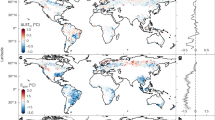Abstract
Forests play an important role in the water and energy balance of the land surface. It has been known since the early studies of Horton (1919) and Rutter (1975) that the water use of forests can be considerably higher than that of vegetation of different structure and height. Subsequent work has elucidated the main factors influencing this behavior (e.g., Shuttleworth and Calder 1979; Shuttleworth 1989). They showed that the combination of a high aerodynamic roughness, with a relative low and strongly controlled surface resistance, was the main cause for high evaporation rates from wet canopies and somewhat low transpiration rates from dry canopies. They also suggested that care must be given to the separate modeling of dry and wet canopy evaporation, and that total evaporation could not simply be derived from equations relating total evaporation to a net radiation estimate. Building on that work, numerous modeling studies at regional and global scale have provided evidence that the interaction of the forests with the atmosphere is a major component in shaping regional to global climate and weather (Nobre et al. 1991; Blyth et al. 1994). Forests not only use more water by evaporating more, they also influence the rainfall patterns and magnitude at regional and global scales by increasing the low level moisture convergence (supply of moisture through horizontal advection in the lower layers of the atmosphere).
Access this chapter
Tax calculation will be finalised at checkout
Purchases are for personal use only
Preview
Unable to display preview. Download preview PDF.
Similar content being viewed by others
References
Blyth EM, Dolman AJ, Noilhan J (1994) The effect of forests on mesoscale rainfall: an example from HAPEX-MOBILHY. J Appl Meteorol 33:445–454
Collatz GJ, Grivet C, Ball JT, Berry JA (1991) Physiological and environmental regulation of stomatal conductance, photosynthesis, and transpiration: a model that includes a laminar boundary layer. Agric Forest Meteorol 54:107–136
Cox PM, Huntingford C, Harding RJ (1998) A canopy conductance model for use in a GCM land surface scheme. J Hydrol 212,213:79–94
Dolman AJ (1987) Summer and winter rainfall interception in an oak forest. Predictions with an analytical and a numerical simulation model. J Hydrol 90:1–9
Dolman AJ (1993) A multiple source land surface energy balance model for use in GCMs. Agric Forest Meteorol 65:2–45
Dolman AJ, Stewart JB, Cooper JD (1988) Predicting forest transpiration from climato-logical data. Agric Forest Meteorol 42:339–353
Horton RE (1919) Rainfall interception. Mon Weather Rev 47:603–623
Jarvis PG (1976) The interpretation of the variations in leaf water potential and stomatal conductance found in the field. Philos Trans R Soc Lond B273:593–610
Jarvis PG, McNaughton KG (1986) Stomatal control of transpiration: scaling up from leaf to region. Adv Ecol Res 15:1–49
Jarvis PG, James GB, Landsberg JJ (1976) Coniferous forests. In: Monteith JL (ed) Vegetation and the atmosphere, vol II. Academic Press, London, pp 171–240
Leuning R (1995) A critical appraisal of a combined stomatal-photosynthesis model. Plant Cell Environ 18:339–357
Martin P, Valentini R, Jaqcues M, Fabbri K, Galati D, Quarantino R, Moncrief JB, Jarvis P, Jensen NO, Lindroth A, Grelle A, Aubinet M, Ceulemans R, Kowalski AS, Vesala T, Keronen P, Matteucci G, Granier A, B erbingier P, Lousteau D, Shulze ED, Tenhunen J, Rebmann C, Dolman AJ, Elbers JE, Bernhofer C, Grunwald T, Thorgeirson H (1998) New estimate of the carbon sink strength of EU forests integrating flux measurements, field surveys and space observations. Ambio 27:582–584
Monteith JL, Unsworth MH (1990) Principles of environmental physics. Arnold, London
Newson MD, Calder IR (1989) Forests and water resources: problems of prediction on a regional scale. Philos Trans R Soc B324:283–298
Nobre CA, Sellers PJ, Shukla Y (1991) Amazonian deforestation and climate change. J Climate 4:957–988
Rutter AJ (1975) The hydrological cycle in vegetation. In: Monteith JL (ed) Vegetation and the atmosphere, vol I. Academic Press, London, pp 111–154
Shuttleworth WJ (1989) Micrometeorology of temperate and tropical forest. Philos Trans R Soc B324:299–334
Shuttleworth WJ, Calder IR (1979) Has the Priestley Taylor equation any relevance to forest evaporation? J Appl Meteorol 18:634–638
Stewart JB (1988) Modelling surface conductance of pine forests. Agric For Meteorol 43:19–35
Valentini R, Matteucci G, Dolman AJ, Schulze E-D, Rebmann C, Moors EJ, Granier A, Gross P, Jemsen NO, Pilegaard K, Lindroth A, Grelle A, Bernhofer C, Grunwald T, Aubinet M, Ceulemans R, Kowalski AS, Vesala T, Rannik U, Berbigier P, Lousteau D, Gudmundson J, Thorgeirson H, Ibrom A, Morgenstern K, Clement R, Moncrieff J, Montagni L, Minerbi S, Jarvis PG (2000) Respiration as the main determinant of carbon balance in European forests. Nature 404:861–865
Editor information
Editors and Affiliations
Rights and permissions
Copyright information
© 2003 Springer-Verlag Berlin Heidelberg
About this chapter
Cite this chapter
Dolman, A.J., Moors, E.J., Grunwald, T., Berbigier, P., Bernhofer, C. (2003). Factors Controlling Forest Atmosphere Exchange of Water, Energy, and Carbon. In: Valentini, R. (eds) Fluxes of Carbon, Water and Energy of European Forests. Ecological Studies, vol 163. Springer, Berlin, Heidelberg. https://doi.org/10.1007/978-3-662-05171-9_10
Download citation
DOI: https://doi.org/10.1007/978-3-662-05171-9_10
Publisher Name: Springer, Berlin, Heidelberg
Print ISBN: 978-3-642-07848-4
Online ISBN: 978-3-662-05171-9
eBook Packages: Springer Book Archive




